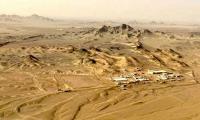Today, June 26, 2019 marks the International Day against Drug Abuse and Illicit Trafficking. Each year the United Nations Office on Drugs and Crime (UNODC) selects the theme for the day and this year the theme is: ‘Health for Justice, Justice for Health’.
If politics makes strange bedfellows, politics and drugs produce even stranger ones. The partnership between drug trafficking and national politics has taken a truly bizarre turn in the fight against the presumed threat to the capitalist system. The history of control of drugs is seldom taught to our people because it could unveil the forces that actually helped the pharmaceutical industry earn huge profits and helped spawn a whole generation of pill-takers hooked on drug-related habits.
Great Britain waged two wars in the mid-nineteenth century to force the entry of opium into China which had banned it. It may seem strange that a mighty nation should have picked on a weaker one and sided with the smugglers of a forbidden drug, but that is what the politics of drug trade is all about. A larger issue was, of course, the opening up of China for commercial purposes, but the immediate cause of war was opium.
It was not out of character for a colonial power of those days to rely on drug behaviour as a major source of revenue for its Treasury, as the British colonial government did in India. Practically all colonial governments in the East did it, and the practice continued until the dissolution of the colonies in the mid-twentieth century. The effect of such fiscal policies on the production and consumption of the drug concerned should be fairly obvious.
The US early in this century took the lead in the attempt to stop the international traffic in opium, partly as a gesture to win over opium-plagued China for economic purposes. When heroin, an opium derivative made several times more potent by technology, was declared illegal in the US in 1914, it went underground and attained apotheosis as the most forbidden fruit. This opened the doors for elements of organised crime to get involved and start feeding the growing habit in the US and Europe.
Then, after World War II the US found itself having to defend an empire against rising challenges to its politico-economic system on the periphery. In turning back these challenges, the US more than once turned for help towards organised criminals and unpopular dictators who enriched them through illicit means, including drug trafficking. Pakistan is one such example.
Since the US-led invasion of Afghanistan in October 2001, the Golden Crescent opium trade has soared. According to the US media, this lucrative contraband is protected by the Taliban and the regional warlords, in defiance of the “international community”. The heroin business is said to be “filling the coffers of the Taliban”. In the words of the US State Department:
“Opium is a source of literally billions of dollars to extremist and criminal groups... [C]utting down the opium supply is central to establishing a secure and stable democracy, as well as winning the global war on terrorism,” (Statement of Assistant Secretary of State Robert Charles. Congressional Hearing, April 1, 2004)
The reality is otherwise. In fact, US foreign policy supports the workings of a thriving criminal economy in which the demarcation between organized capital and organized crime has become increasingly blurred. The heroin business is not “filling the coffers of the Taliban” as claimed by the US government and the international community. In fact, it is quite the opposite. The proceeds of this illegal trade are the source of wealth formation, largely reaped by powerful business/criminal interests within the Western countries. These interests are sustained by US foreign policy. Decision-making in the US State Department, the CIA and the Pentagon is instrumental in supporting this highly profitable multibillion dollar trade, third in commodity value after oil and the arms trade.
The heroin trade was part of the war agenda. What this war has achieved is to restore a compliant narco-state, headed by a US-appointed puppet. The powerful financial interests behind narcotics are supported by the militarization of the world’s major drug triangles (and trans-shipment routes), including the Golden Crescent and the Andean region of South America (under the so-called Andean Initiative).
The accumulation of vast assets by the drug barons in Pakistan has enabled them to continue large-scale operations even after the arrest of some of their leaders (although they have also managed to defy proper investigation and have had themselves released). Over the past decade, the drug barons in Pakistan have established themselves as patrons of politicians and government functionaries.
Drug production and trafficking are big business. The product is lucrative, needs no advertisement and keeps the customers coming back for more. The individuals and cartels running this deadly trade in Pakistan are influential and ruthless; they have successfully managed to counter all efforts aimed at curtailing their activities.
The situation is serious, but not hopeless. In recent years, the government has come to realise that illegal drug trafficking and drug abuse are a global problem and require a national response with international coordination. However, the government has not yet been able to launch an effective drug control programme primarily due to paucity of funds as well as the lack of a real understanding of the problem by the law-enforcement apparatus.
The writer is an advocate of the Supreme Court and adjunct faculty at LUMS.
Email: ikram@huzaimaikram.com
Twitter: @drikramulhaq
Disturbances that began in 2023 with attack on school have escalated rapidly in recent weeks
Obvious ineptness and lack of empathy that underpins our criminal justice system need not be recounted
Women constitute about 22.63% of formal labor force, while men make up 84.79%
Responsibility falls on Global North to address issues facing Global South before it collapses entirely
FAO recognises home gardening as crucial strategy to enhance household food security and nutrition, particularly in...
Pakistan’s judicial system has evolved in a complex manner since country’s inception







